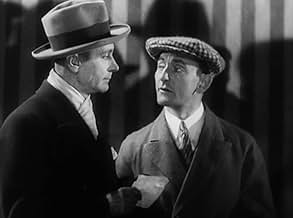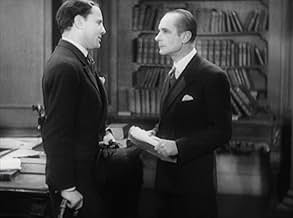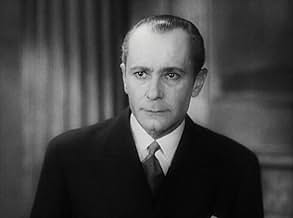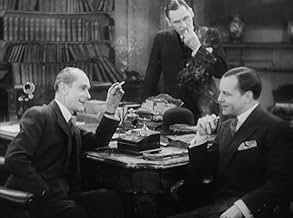Mary
- 1931
- 1h 18min
CALIFICACIÓN DE IMDb
5.7/10
1.1 k
TU CALIFICACIÓN
Agrega una trama en tu idiomaA juror in a murder trial, after voting to convict, has second thoughts and begins to investigate on his own before the execution.A juror in a murder trial, after voting to convict, has second thoughts and begins to investigate on his own before the execution.A juror in a murder trial, after voting to convict, has second thoughts and begins to investigate on his own before the execution.
- Dirección
- Guionistas
- Elenco
John Mylong
- John Stuart
- (as Jack Mylong-Münz)
Opiniones destacadas
For Hitchcock completists only, this German-language version of the same director's Murder! tells the same story on the same sets, but with different cast, as a juror questions the guilty verdict he helped come to.
A few mildly amusing visual flairs are present here: jurors seated around a circular table. The camera pans along and we see a first juror held deep in thought; the next several are listening with rapt attention; until we arrive at one man who is clearly bored to tears with it all; a mild joke which was thrown in to the German version, not in the UK version. Brief glimpses (again) of cross-dressing, which Hitch later went back to, in a big way, with Psycho.
Some early quick cuts are surprising, eleven cuts in a three seconds-long scene at the twenty three minute mark. Most unconventional at the time.
Overall the movie is watchable, but not very involving, partly at least due to its lax pacing, and a verbose screenplay. Like its UK counterpart, however, it does pick up for its memorable climax.
A few mildly amusing visual flairs are present here: jurors seated around a circular table. The camera pans along and we see a first juror held deep in thought; the next several are listening with rapt attention; until we arrive at one man who is clearly bored to tears with it all; a mild joke which was thrown in to the German version, not in the UK version. Brief glimpses (again) of cross-dressing, which Hitch later went back to, in a big way, with Psycho.
Some early quick cuts are surprising, eleven cuts in a three seconds-long scene at the twenty three minute mark. Most unconventional at the time.
Overall the movie is watchable, but not very involving, partly at least due to its lax pacing, and a verbose screenplay. Like its UK counterpart, however, it does pick up for its memorable climax.
A woman is found murdered with another woman, Mary Baring, with whom she'd been heard to be arguing, present, in a daze. It seems like an open-and-shut case and Baring is put on trial for murder. During deliberations, 11 of the 12 members think she's guilty. The sceptical one is Sir John Menier who thinks there are holes in the case. However, he is talked round and Baring is found guilty. After the case Menier still has his doubts and wishes he'd been more forceful in arguing against a guilty verdict. He starts to do his own investigating.
In 1930 Alfred Hitchcock released Murder!, an intriguing murder-thriller. While Murder! Was being shot, Hitchcock was simultaneously making Mary, a German-language version of it, using the same sets but German actors. Mary is almost frame-for-frame and word-for-word (once translated!) the same as Murder! Though manages to run 19 minutes shorter. German must be a more succinct language than English...
The end result is almost as good as Murder! An original start, introducing much of the circumstances around the murder via a murder trial and introducing the main character, Menier, through the jury's deliberations.
The plot developments are good and the climax is quite Shakespearean, which is appropriate considering that the setting is the theatre and most of the characters are theatre actors and crew.
I watched the two films less than day apart and Murder! Was fresh in my mind when I watched Mary. Production values seem a bit lower on Mary and Hitchcock makes less use of clever camera angles in Mary. On the plus side, the irritating smash cuts in Murder! Are not there in Mary. Being longer, Murder! Seems more tension-filled too.
The subtitling on the version of Mary I watched was quite shonky, which also detracted from the film.
Now for the big question: why did Hitchcock make a German version of Murder!? I guess that sound in movies was so new and primitive that simply dubbing Murder! Into German wasn't an option. In the silent era a movie could easily be adapted into another language - just change the dialogue cards!
But why bother at all? My guess is that Germany was a large cinematic market and/or Hitchcock had a large fan base in Germany, hence a film specifically for that market. It's like (30 years later) the Beatles re-recording and releasing many of their early stuff in German.
It's worth noting that this was the one and only time Hitchcock made a foreign-language version of one of his movies. Either Mary wasn't as good an idea as he imagined or technology improved and soon after this his films were dubbed or sub-titled for foreign audiences.
In 1930 Alfred Hitchcock released Murder!, an intriguing murder-thriller. While Murder! Was being shot, Hitchcock was simultaneously making Mary, a German-language version of it, using the same sets but German actors. Mary is almost frame-for-frame and word-for-word (once translated!) the same as Murder! Though manages to run 19 minutes shorter. German must be a more succinct language than English...
The end result is almost as good as Murder! An original start, introducing much of the circumstances around the murder via a murder trial and introducing the main character, Menier, through the jury's deliberations.
The plot developments are good and the climax is quite Shakespearean, which is appropriate considering that the setting is the theatre and most of the characters are theatre actors and crew.
I watched the two films less than day apart and Murder! Was fresh in my mind when I watched Mary. Production values seem a bit lower on Mary and Hitchcock makes less use of clever camera angles in Mary. On the plus side, the irritating smash cuts in Murder! Are not there in Mary. Being longer, Murder! Seems more tension-filled too.
The subtitling on the version of Mary I watched was quite shonky, which also detracted from the film.
Now for the big question: why did Hitchcock make a German version of Murder!? I guess that sound in movies was so new and primitive that simply dubbing Murder! Into German wasn't an option. In the silent era a movie could easily be adapted into another language - just change the dialogue cards!
But why bother at all? My guess is that Germany was a large cinematic market and/or Hitchcock had a large fan base in Germany, hence a film specifically for that market. It's like (30 years later) the Beatles re-recording and releasing many of their early stuff in German.
It's worth noting that this was the one and only time Hitchcock made a foreign-language version of one of his movies. Either Mary wasn't as good an idea as he imagined or technology improved and soon after this his films were dubbed or sub-titled for foreign audiences.
This is the only time in Alfred Hitchcock's career that he remade one of his own films in another language; just like in "Murder" (1930), there is one piece of brilliant filmmaking (the entire jury sequence), but the rest of the film is dull, primitive and plodding - strictly for Hitchcock completists. Mary (Olga Tschechowa) is very beautiful. ** out of 4.
Is it merely a German version of Hitchcock's "Murder!"? True both films are based on the same source-material. Yet the outcome is different. There is more emphasis on choice of camera and shots and editing in the German film than in the British one. The underlying cross dressing and gay aspects are more obvious in the German film. Yes "Mary'' can be considerably compared to Lumet's "12 Angry Men" made decades
later. Here the juror becomes the detective, while in Lumet's film the juror never really leaves the jury room. The relationship between juror and the accused is explored midway--a rare aspect in any jury-oriented tale. It is therefore goes one up on "Murder!" Further, Alfred Abel (a German actor) is superior to Herbert Marshall both playing the same character of the same tale, that of Sir John Menier. So is Olga Tschechowa playing the role of the accused actress, facing death sentence.
For all practical purposes, a remake, in German, of "Murder!" It is stark and frantic, but the plot is the same. The editing is flawed and so things do not move fluidly. Also, the actors seem more stiff and less interesting. It's as if Hitchcock felt he could give the German people a gift, but move on quickly. I agree that the tension is much less. The final scene is one of the most dramatic of any the master produced, but here it doesn't have quite the same impact. See it only if you wish to have a full view of early Hitchcock films. That was my motivation.
¿Sabías que…?
- TriviaA copy of the film is included as a bonus feature on the Kino Lorber Studio Classics DVD and German DVD releases of Murder! (1930) and the French DVD release of La posada maldita (1939).
- ErroresAs Sir John interviews Mary in jail, it is established in long-shot that both are sitting at opposite ends of a long table. During frontal closeups, the widths of the planks that make up the tabletop reveal that very randomly either the table is turning between shots or both persons repeatedly switch places.
The exact same continuity error also applies to the American version of the movie, Murder! (1930).
- ConexionesAlternate-language version of Murder! (1930)
Selecciones populares
Inicia sesión para calificar y agrega a la lista de videos para obtener recomendaciones personalizadas
Detalles
- Fecha de lanzamiento
- Países de origen
- Idioma
- También se conoce como
- Secreto de la noche
- Locaciones de filmación
- Productora
- Ver más créditos de la compañía en IMDbPro
- Tiempo de ejecución1 hora 18 minutos
- Color
- Relación de aspecto
- 1.20 : 1
Contribuir a esta página
Sugiere una edición o agrega el contenido que falta

Principales brechas de datos
By what name was Mary (1931) officially released in Canada in English?
Responda






























